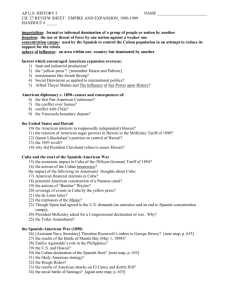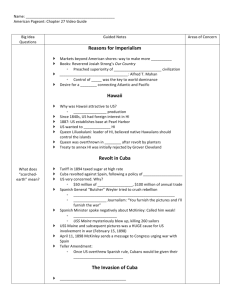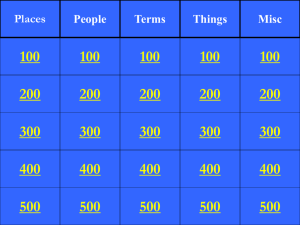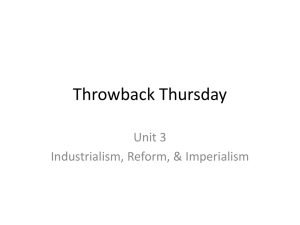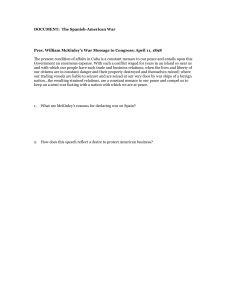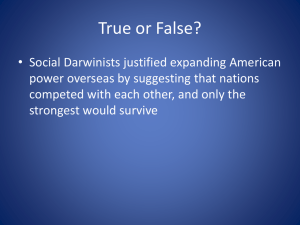Ch. 27: Empire and Expansion
advertisement
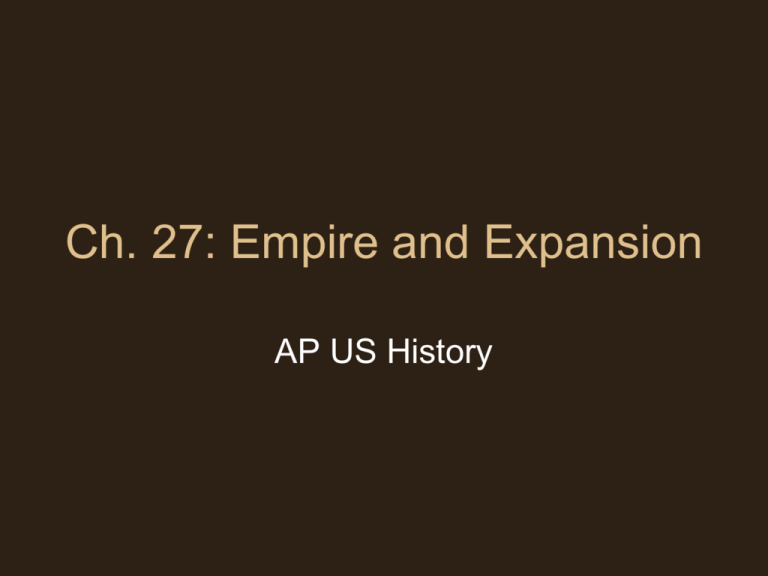
Ch. 27: Empire and Expansion AP US History America Turns Outward • By the 1890s America turned from its inward policy (isolationist) to and outward policy (imperialism). – European nations had been land grabbing throughout the 1800s. (Africa) America Turns Outward • Reasons for Imperialism 1. Yellow Journalism • Stirred up desire of people for adventure 2. Missionaries wanted to save souls • Rev. Josiah Strong wanted to Christianize the exotic lands. Our Country: Its Possible Future and Its Present Crisis 3. Social Darwinism • • Supported by people like T.R and Henry Cabot Lodge Stronger nations should conquer the weaker nations. 4. Naval Race • • Cap. Alfred Mahan wrote The Influence of Sea Power Upon History, 1660-1783. Key to nations power is through their naval power America’s Close Calls • The US had several close-calls or balancing acts during this time. – James G. Blaine advocated the “big sister” policy. • Idea was to get Latin American countries behind the leadership of the U.S. – Pan-American Conference held in Washington D.C America’s Close Calls • Other conflicts… – US-Germany (Samoa islands) – US-Italy (Captured Italians in New Orleans) – US-Canada (seal hunting rights) – US-Britain (Gold discoveries in Venezuela) • US just stuck up for her “little sister” • Defended Monroe Doctrine (European nations were to stay out of Western Hemisphere) – Almost led to war but Britain backed off due to threats to their South African colonies by Germany. America turns its eyes to Hawaii • America turns its eyes to Hawaii – Americans regarded it as an extension of the US. • Shippers, sailors, whalers and missionaries where there. – American companies ran islands economics • American fruit/sugar companies entrenched in Hawaii – Natives grew restless towards the Americans • Disease killed many natives • Japanese/Chinese brought in as workers. America turns its eyes to Hawaii • Sugar companies wanted to take Hawaii for good. – REASONS: 1. Worried of Japan trying to take over 2. McKinley Tariff raised prices of goods when imported to US. America turns its eyes to Hawaii • Queen Liliuokalani resisted. – Said natives should run Hawaii • Washington worked on legislation to annex Hawaii. – Before it could pass Congress Harrison was replaced by Grover Cleveland as President. • Cleveland stopped the annexation b/c he didn’t like the way Hawaii was taken over. Cubans Rise in Revolt – 1895 Cuba revolts against Spain • The Cuban “insurrectos” revolted against Spanish overlords on Sugar plantations. – Burned everything Cubans Rise in Revolt • The US rooted for the Cubans – REASONS: 1. America loved liberty and independence 2. Yellow Journalism 3. Good for Monroe Doctrine to get rid of another European nation 4. Cuba was a gateway to Caribbean – dreams of Panama Canal Cubans Rise in Revolt • Spain sent Gen. Valeriano “Butcher” Weyler to stop the revolt. – He started prison camps for the insurrectos. – America’s “yellow press” ran with this. – Frederic Remington is sent by Hearst to draw pictures. • “You furnish the pictures, I’ll furnish the war.” Cubans Rise in Revolt • De Lome letter: letter from Spanish official Dupuy de Lome criticizing Pres. McKinley. • U.S.S Maine exploded at night in Havana harbor killing 260 American sailors. – Cause was a mystery (public thought Spain had done it) – American public called for war “Remember the Maine” • McKinley finally gave in and sent message asking for war to Congress. • April 11, 1898 Congress voted for war w/ Spain. • Teller Amendment: Said the US would give Cuba its freedom after ridding it of Spanish rule. Dewey’s May Day Victory • America enters war with confidence and excitement. Spanish-American War – Before war is declared Teddy R ordered Commodore George Dewey to move to Philippines if war broke out. (Spanish control) – Dewey carries out orders May 1, 1898 Dewey’s May Day Victory • America’s 6 ships (new) defeated the 10 Spanish ships (old) easily. – Dewey won battle but couldn’t take island with sailors. • US takes island quickly when foot soldiers reinforce Dewey’s sailors. • Now US wants Hawaii as way station in Pacific. – McKinley and Congress agreed to annex Hawaii on July 7, 1898 (5 years after first attempt) Confused Invasion of Cuba • American’s ill prepared for war – Clothing for fighting in sub-zero temps not Cuba. • US led by Gen. William Shafter – Rough Riders: organized by Teddy R. • Calvary had to fight on foot b/c no plan to get horses to Cuba. Confused Invasion of Cuba • Spanish fleet used narrow harbor at Santiago to enter Cuba. • US blockaded the Spanish fleet in Harbor as Army went ashore further up the river. – US forces suffocated the Spanish forces. – Destroyed Spanish ships as they tried to escape. Confused Invasion of Cuba • “Splendid Little War” Sec. of State John Hay • Spain signed an armistice on August 12, 1898. – 4,000 US soldiers died from battle – 5,000 die from disease America’s Course (Curse?) of Empire • Peace negotiations held in Paris to “settle” the war… – Treaty of Paris 1. Cuba was free and independent (Teller Amend) – Stipulations to this: (Later in notes) 2. US gained (1) Puerto Rico, (2) Guam, and (3) assumed control of Philippines. America’s Course (Curse?) of Empire • Philippines posed biggest problem… – American Options/Consequences 1. Give back to Spain – decades of misrule 2. Let Filipino people run own country. – Thought warlords of country would compete and result in chaos. 3. US takes over islands (McKinley’s choice) – – US would look like imperial bully. Filipino people didn’t want this (just got rid of Spain) America’s Course (Curse?) of Empire Anti-Imperialists • Emerged to halt annexation. • • Difference now is that prior lands were generally N. America. (Alaska, Hawaii little pop) Mark Twain and Andrew Carnegie were among its members Imperialists • Argued Philippines could flourish economically. – Rudyard Kipling wrote “The White Man’s Burden”: encouraged US to civilize Philippines. Answers Question that had remained: Should Senate accept treaty and acquire Philippines. Perplexities in Puerto Rico and Cuba • PR was now owned by the US but not a state or territory. – Foraker Act: gave it limited elected Gov. – Full US citizenship given in 1917 – Many improvements (sanitation, transportation, etc.) – QUESTION: • Do American laws and rights apply to these lands and peoples? – Insular Cases: Supreme Court declared America’s laws and customs do not necessarily extend to these new lands. Perplexities in Puerto Rico and Cuba • The Teller Amendment had said the U.S would leave Cuba to be independent. – Set up military Gov. and made many improvements up to that point. (Col. Leonard Wood) – US leaves in 1902 • Platt Amendment: 1. Cuba can’t make treaties US didn’t like 2. Cuba couldn’t take on too much debt (US intervention) 3. Cuba must lease coaling stations to US military. 1. Guantanamo Bay New Horizons in Two Hemispheres • Results of the “splendid little war” 1. US is a world power (Likely strongest) • Nations increased diplomatic headquarters in D.C 2. America became patriotic 3. A strong military was accepted a need • Sec of War Elihu Root started a War College 4. The North-South divide seemed to narrow – Enemy ceased to be one another and was Spain 5. The Philippines became a thorn in America’s side. “Little Brown Brothers” in the Philippines • Filipinos thought they would get their freedom like Cuba. – Felt betrayed by the American’s • An insurrection began against the American troops by the Filipinos on Feb 4, 1899 “Little Brown Brothers” in the Philippines • Emilio Aguinaldo was the leader of the insurrection. – • He had fought for America against Spain America’s Response 1. “Water Cure” = cooperation 2. Prison camps (like “Weyler in Cuba) 3. Attacking people who just wanted freedom “Little Brown Brothers” in the Philippines • US gained upper hand in 1901 – Sent William H. Taft to be the civil governor of the Philippines. • Called the natives his “Little Brown Brothers”. – His relations with the natives was generally very good. “Little Brown Brothers” in the Philippines • Taft’s policy = “benevolent assimilation” – Use of kindness to civilize the people (Slow) – SUCCESS of TAFT: 1. Infrastructure improved (roads, sanitation, etc) 2. Trade increased, mainly sugar (Americans/Philippines) 3. Schools (Built and staffed) • Filipinos still want FREEDOM! • July 4, 1946 after WWII Hinging the Open Door in China • Japan defeated China in 1894-1895 – Europe slices China into “spheres of influence” • • • European nations controlled trade rights in cities EX: Britain controlled Hong Kong (despised) America’s Concerns 1. Missionaries concerned over access 2. American business worried of losing markets. Hinging the Open Door in China • Sec. of State John Hay – Open Door Policy: says spheres of influence should be dropped and Chinese cities should be open to all nations for business. • Europe was not interested in losing their markets Hinging the Open Door in China • Boxer Rebellion: Chinese rose up to oust/kill foreigners who controlled their cities. • 200 foreigners/thousands of Chinese Christians killed – Europe and US crush Chinese uprising. • Chinese have to pay $333 million in damages – $24.5 million to US (Give $18 million to Chinese students in America) – Open Door Policy reissued • Accepted and China’s borders were to be respected an its cities open to trade to all. Imperialism or Bryanism in 1900 • William Jennings Bryan v. William McKinley (1900 Election) – Bryan toured the nation again – McKinley stayed at home • Teddy R (VP) campaigned the country. • McKinley wins re-election easily TR: Brandisher of the Big Stick • McKinley is shot 6 months after election – TR becomes the youngest president ever at age 42. – “Speak softly and carry a big stick” • He is not silent • Believe the president should lead, and he did. • Considered the first modern president. Building the Panama Canal • America wanted a canal across Central America – REASONS: 1. Would boost business in Latin America 2. Would make the US navy even stronger (Mobility) – BARRIERS: • Clayton-Bulwer Treaty- Treaty signed w/ Britain which said the US could not control an isthmus route alone. (1850) – Hay-Pauncefote Treaty 1901: Gave US ok to work alone Building the Panama Canal • Where should the canal be? – 1st choice = Nicaragua – 2nd Choice = Panama • French company (Philippe Bunau-Varilla) had failed at their attempt. • Price of canal holdings went from $109 Million to $40 Million (Congress agrees to try) • PROBLEM: Panama was part of Colombia Building the Panama Canal • US Addresses the Problem: 1. T.R tries to lease land (Senate rejects deal) 2. Bunau-Varilla incites a Panamanian riot on Nov, 3 1901: (US offshore for assistance) – Revolution is success 3. T.R recognizes Panama as independent and the Hay-Bunau-Varilla Treaty is signed. – Leased canal to US for $10 Million and $250,000/year for 10 mile wide canal strip. – Beginning of Bad Relations with Latin America for US Building the Panama Canal • Construction began in 1904 • Obstacle #1: Sanitation – Col. William C. Gorgas helped drain swamps and eradicate mosquitoes/disease. • Obstacle #2: Size of Project – Col. George Washington Goethals engineered the task. • Completed in 1914 • Cost: $400 Million TR’s Perversion of the Monroe Doctrine • Roosevelt is in a tight spot when many Latin American nations default on their loans to European Nations. – OPTIONS: • Let European leaders collect and violate Monroe Doctrine • Allow delinquency of payments – CHOICE: • Roosevelt Corollary: An addition to the Monroe Doctrine. TR’s Perversion of the Monroe Doctrine • Roosevelt Corollary: – The U.S would intervene in Latin America and collect debts for Europe. (World Police) • Addition was that not only will Europe not intervene but the US would intervene on their behalf. • Latin American nations did not appreciate Roosevelt's “Big Stick” Policy TR’s Perversion of the Monroe Doctrine Roosevelt on the World Stage • TR gets his start on international stage in 1904. (Russia and Japan go to war) – Dispute over the Manchuria area • Both nations wanted the Sakhalin islands. • Japan calls for TR to be peace negotiator – Ironic that the War Hawk is going to negotiate peace – Treaty negotiate at Portsmouth, NH 1905 – Both Russia and Japan left unhappy with result of treaty but war was over. – TR would be awarded the Nobel Peace Prize 1906 Japanese Laborers in California • “yellow peril” engulfed California in early 1900s with a flood of Japanese immigrants – Only 3% • In 1906 the San Francisco School Board segregated Chinese, Japanese and Korean students. • Roosevelt mediated the “Gentlemen’s Agreement” – School board would stop segregation – Japan would stop emigration of laborers to California Japanese Laborers in California • Roosevelt ordered the “Great White Fleet” on a diplomatic good-will tour around the world. – Really to show US is not scared of Japan/military muscle. – Root-Takahira agreement: signed by US and Japan. • Both nations promised to respect one another’s territorial boundaries and honor China’s Open Door Policy.

